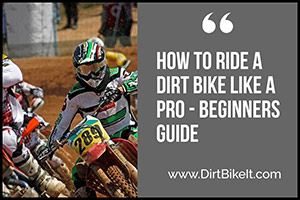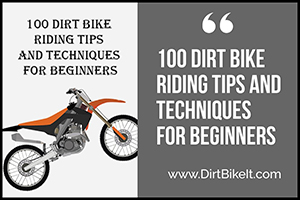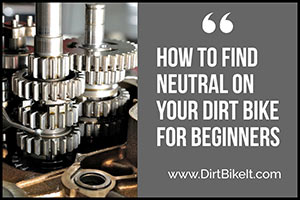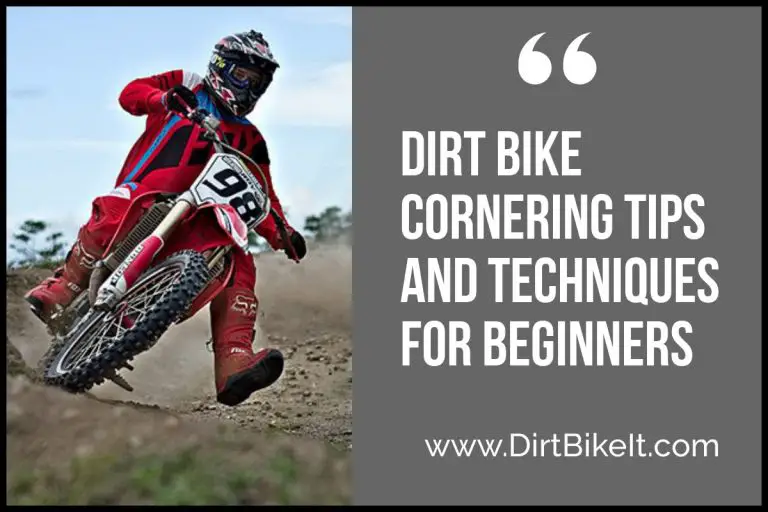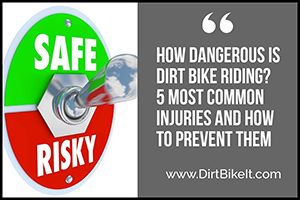How to Ride a Dirt Bike Like a Pro – Beginners Guide
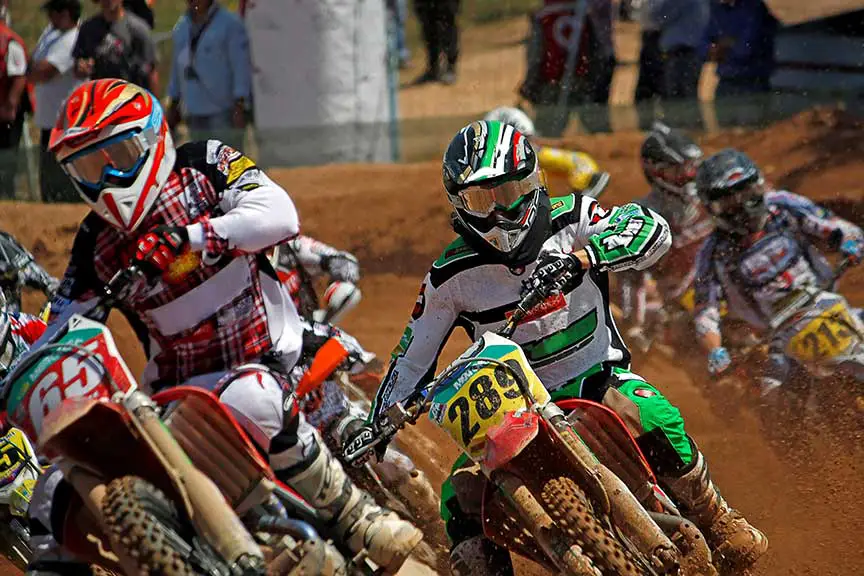
How to Ride a Dirt Bike Like a Pro
For those of you who are looking to find out how to ride a dirt bike like a pro, you are in luck. We have compiled a whole list of tips for you so that you can get the most out of your dirt bike riding experience.
Inspection Checklist for Before you go Dirt Bike Riding
In all likelihood, if you rely only on memory, you won’t remember everything you need to inspect before you take your dirt bike out for a ride, necessitating that you keep a checklist handy before you go out to ride. If your bike is not properly inspected for the various factors listed here before the ride, you risk causing serious damage to it in both the short and long runs. Consider the checklist you keep a part of maintaining your bike, working it into your overall routine, keeping your bike running smoothly for years on end, making each ride glitch-free and memorable. So, don’t rely on memory but write your checklist down, lest in the flurry of activity you forget something essential. The checklist that follows applies equally for dune riding, trail riding and motocross. While some items on the checklist can be dealt with at home, others can only be dealt with once you have reached your destination. Therefore, keep a printed copy of the checklist with you, or store it in your tablet or smartphone, some place you can easily access it from anywhere.
Check the Oil Level
In all probability, this is something you will remember without being reminded to but check to make sure that your bike doesn’t run low on oil. It will cause tremendous damage to the engine if it does. Make sure, also, that you change the oil at the appropriate times.
Check the Air Filter
This is pretty much as important as checking the oil, but just to make sure that you remember to, keep it on your checklist.
Check the Level of the Coolant
Checking the coolant level is essential for riding of all types, but particularly more so when it comes to dune riding. This additionally serves as a great method of checking whether or not your bike has some sort of leak as well as checking for other problems with your bike’s engine.
Check the Fluid Level of the Brake
This is similar to checking the level of the coolant in that it’s a great method to identify other underlying problems. The fluid ought not to change a lot, if it changes at all. Should your brakes feel spongy, it signifies that it is time your brake fluid was changed.
Check Sprocket and Chain for Wear
This check is fairly easy. Examine your sprockets to check that its teeth are worn, cupped or bent. Examine the chain for rush as well as for signs that it has corroded. Corrosion manifests as a wear pattern that is flat on the bottom of the top. The whole drive will have to be replaced if you see these signs.
Check Lube and Chain Slack
This is strongly connected to checking the sprocket and chain for wear. Once you have done that part, make sure that the slack is at the ideal level for riding. After that, to adequately lubricate, apply a fresh coat. Between two and three fingers of slack is a good guideline to check on chain sag.
Tighten the Spokes
Take a few minutes to quickly tighten each of the spokes. Don’t use your finger to check; make use of the proper tool. Make sure you check on every third one till all of them have been checked.
All the Nuts and Bolts have to be Tightened
After tightening the spokes, check the nuts and bolts keeping your bike intact.
Check the Control Levers and Adjust them
Make sure that everything feels and works fine. Ensure that the levers remain in the optimal position they were in during your last riding day. Adjust them well before the riding commences.
Setting the Sag
Another important aspect to check is the distance between the swing and the fender arm first. Do this first while the rider is off of the bike and next with the rider sitting on the bike. Should you have sag over 105mm, turn the spanner ring in a clockwise direction, adding free-load to the shock spring.
Checking Air Pressure
The air pressure does change according to elevation. Therefore, check this right before you get on your bike to ride. Don’t check the air pressure in your tires at home. Wait until you are in the place where you’re going to ride.
Bleeding the Forks
This is another item you should leave until you are at your destination. Like tires, air in the works also changes according to elevation.
Check the Gas
This is another essential part of successful dirt bike riding.
Once you have checked every item on this checklist, you are ready to go dirt bike riding.
Starting the Bike
Dirt bikes don’t come with keys. They are either kickstart or electric start, requiring either kicking a pedal or pushing a button.
There is a difference between simply starting your dirt bike and starting it properly. If you are observant at riding trails and tracks, you are bound to see people struggling with starting their bikes. There are two forms of starting your dirt bike, the cold start and the hot start.
The Cold Start
The cold start refers to starting your dirt bike while your engine is still cold. This is the case when you first set out to ride on any given day. First of all, make sure that your gas tank is full and, in case the bike’s got a petcock, turn on the gas. Pull the bike’s choke or its starter valve if this applies to your bike. Make sure your bike is in neutral. Then hold in the clutch levers and your front brake. Now you are ready to kick start your bike.
If you’re on a 2 stroke bike, kick swiftly and fully, this being the most common method to start 2 strokes.
If, on the other hand, you ride a 4 stroke, slowly push the kick starter up and down, gently cranking the engine. When you sense that the engine is ready, kick fully, making a full stroke. If you keep using short kicks, the bike won’t start.
There are newer models of dirt bikes that are fuel injected, and come without batteries, having an energy-storing capacitor in their place, operating the injector and fuel pump. If this capacitor sits doing nothing for long time periods, is loses energy, similar to dead batteries, preventing your bike from starting. If this happens, the problem can be solved by rolling the kick starter a few times, charging the capacitor, giving the injector and fuel pump the energy requires to provide fuel to the engine.
Once you have started your dirt bike, allow it to idle, reaching operating temperature. Then switch off the starter valve or choke and go ride your dirt bike.
The Hot Start
The engine can shut off once the bike is up and running due to a variety of reasons, such as the rider mishandling the bike’s clutch or in the event of a crash. Many bikers struggle to get the bike re-started at this point and can grow extremely frustrated, panic setting in as their competition races ahead, or their friends continue riding. One of the most important things to do if this happens is to stay relaxed. Impatience simply robs you of focus, preventing you from realizing that you’re going about starting your bike in the wrong way. Make sure you don’t use the choke in such a scenario, instead using the hot start. Make sure your bike is in neutral. Hold in the clutch levers and the front break. On the compression stroke, roll your kick starter to a full stroke. Ensure that you don’t repeatedly twist the throttle, something that can happen when you’re frustrated and impatient, something that only floods the bike’s engine. Kickstart your bike. While you’re caught up in the middle of doing all this it may feel like it’s taking a long time, like five minutes but in reality, the whole process takes around five seconds. It’s something you do in the correct manner all the time but forget to do in the heat of the moment. So, take a deep breath and re-start your bike correctly or you’ll flood your engine and possibly damage your bike.
Clutch Control and Shifting
Learning how to use a clutch on a dirt bike can seem like a daunting prospect, pressurizing a rider whose hands and feet are already busy with the gas and breaks. And yet it is relatively simple, similar to using stick shift while driving a car, many of the same principles applying. Once you get a handle on it and it becomes second nature to you, you will wonder what on earth you were worrying about. If you’ve only driven automatic vehicles before this or haven’t yet reached driving age, you may have difficulty understanding the concepts laid down here, at least at first. But once you develop a firm grasp over the principles of using the clutch on your dirt bike, it will never trouble you again, and it will be a skill that can easily transfer to driving stick shift cars as well.
You will find the clutch on the handlebars’ left side, similar in appearance to the brake lever that is located on the right side. To help you remember, just keep in mind that the gas and brakes are together, the gas being the right grip, the ideal spot for the lever for brakes.
The clutch pedal in stick shift cars and the clutch lever in dirt bikes work identically to one another. Changing gears in a stick shift requires pressing down on the clutch. Just as you push the car’s clutch pedal with the left foot, so too you press the dirt bike’s clutch lever using the left hand.
Just before the left boot peg of your dirt bike you will find the shifter through which you shift through the gears. Your left foot can easily access it, enabling you to shift through the gears quite easily as you’re racing through the trail or on a track. And exactly like it does with a car, it takes practice over time to get the hang of shifting through the gears using your left foot, pressing the clutch with your left hand and controlling the brakes and gas with your right hand.
The ideal way to practice and become comfortable while using the clutch on your dirt bike is by first finding a flat and open stretch of land. Make sure there are minimal obstructions in the path you’re going to ride on.
The first step is to start your bike. Once the engine is running, become acquainted with the gas and the clutch, both of which have to be employed in unison to get you moving. When you start your bike is in neutral, between the first and second gears. Shift down in order to hit the first gear; shift up to hit the second and third gears and so on. To get into first gear, squeeze down on the clutch just like you would the brake to stop your bike. While the clutch is squeezed, push your bike’s shifter down using the left foot. This will put you in first gear.
Then, exactly like you would do while driving a car, slowly release the clutch from your left grip while rotating your right wrist to give the bike some gas. This will start you moving. Be careful to follow this process using the right balance; if you release the clutch too soon your bike will stop; if you give it more gas than required your bike is going to take off and leave you lying on the ground. So, remember to release the clutch slowly, simultaneously giving gas to the bike.
When you have done this correctly, the bike will ride along smoothly, you having completely released the clutch. You will also be giving it some more gas. You will be able to hear the RPMs rising and the bike will not go a lot faster. Now is the time to try getting into second gear. The same process is repeated: you squeeze on the clutch, pressing the shifter up and then release. This time, you will not have to be as careful with your release of the clutch as you did when you went from neutral to first.
You can repeat the process once more to get into third gear from second and so forth. The majority of bikes possess five gears; others have four; and yet others six. Should you forget the use the clutch, a grinding sound from your bike’s transmission will let you know of the fact. If you do not use the clutch to change gears, you will eventually have to replace your transmission.
For down shifting, press the lever down with your foot. This is the most challenging aspect of learning to shift gears manually on your dirt bike. Since the boots worn while dirt bike riding are big and a lot less flexible than sneakers, you may face difficulty shifting the lever up and down with them. However, time and practice will improve the situation immensely.
Make sure you remove your foot from the shifter and place it on the peg while riding or else you may find yourself pressing on the shifter accidentally, not holding the clutch, damaging your transmission. Eventually, with time and practice, the process will become second nature to you, and you will learn to juggle all the variables without thinking twice about it.
How to Properly Use Your Brake
A lot of people don’t know this, but there are actually three brakes in your dirt bike. There’s the front brake, located on the right side of the handle bar, the rear brake, located near the right foot peg, and the engine brake, which is shifting down without the clutch in. When you’re just getting started with dirt bike riding, leave your front break alone for the most part, focusing more on the rear break. As a general rule, as beginners we use the rear brake 70% of the time and the front brake 30%. As you gain more experience on your dirt bike, that ratio will adjust itself until it’s about 50-50. If you’re riding in sand, you will end up using a little more of the rear brake and a little less of the front. If, on the other hand, you’re on tacky terrain, you will end up using more of the front brake and less of the rear, the ratio being around 70-30 in favor of the front brake.
Body Position While Braking
Stand on the bike in the central standing position, your knees firmly gripping the bike to prevent you from falling over on the rough terrain, your hips stacked firmly over the pegs, your weight towards the back of the bike. Make sure your foot moves from the front to the back while you’re braking. Also make sure that your toes don’t protrude outwards, robbing your knees of their squeezing power. When you brake you have to keep your body position balanced. The harder you apply the brakes, the further back and lower over the bike you want your body to be; the less you apply the brakes, the less back your body has to be. So, when you’re powering forward, keep your body forward; when you apply the brakes, move your body back, using your hips to guide your motion. A good drill to practice your body position is to set up two cones and ride through them, powering forward (your hips and body move forward) through the first cone, and braking (your hips and body move back) when you reach the second cone. Once you get adept at this drill, try doing it with one hand, making sure that your upper body isn’t engaged when your brake. Your upper body doesn’t need to be engaged, as it is your lower body that does the balancing for you.
Gas: What to Use, What to Watch Out For?
Once you have changed the oil in your bike, installed a new clean air filter, added fresh coolant, installed a new pipe and checked your tires, you need to pick the best motocross gas for your bike. You won’t find a pump station that specializes in motocross gas near the track, so you have to know beforehand what you’re looking for.
87, 89, 92 and race fuel all work with your 4-stroke bike. For your 2-stroke, you will need to blend whichever gas you use with a premix. You can save money by opting for the cheaper 87 octane or, if you want to spend more, you could go for the 92 to take you faster. But they all more or less accomplish the same task: starting your engine, getting you around wherever you go riding.
Generally speaking, each gasoline company acquires its gas using the very same pipeline. Once they have the gas, each company adds its own special ingredient, each making the case that their product is the best. These companies then hire the very same distributor to provide their fuel to the various individual stations.
There’s no point in fussing over whatever merit the additives might possess; whatever they add after production isn’t really significant. However, some people believe that their dirt bikes are more suited to one company’s fuel than another’s, or that the expensive gas burns better than the cheap one. However, we recommend that you don’t fuss too much over what gas you use. The tire pressure has more of an impact on how your bike rides that the gas you use.
Racing fuel is more expensive that regular gasoline and has a nice smell, but it probably won’t provide beginners with any tangible benefits. Racing fuel is for the pros who possess the means and the skills and the bike setup to extract a minor gain in performance from it. If you’re competing with the greatest riders that the world has to offer in a competition, racing fuel could make the difference between you ending up in the first place and second. But when you’re riding with amateurs, people just trying to have some fun, racing fuel can be a bit of a waste of money. You would be better off spending the money you save by purchasing ordinary 87 octane gas on aftermarket upgrades, buy new parts that will serve you will on the track.
If, however, your dirt bike has been tuned to run at higher octane, you will need to make an investment in high octane fuel. The higher compression piston, for instance, may cause detonation of the fuel (resulting in knocking) as opposed to burning, affecting performance. Make sure you check your dirt bike’s owner’s manual for this. The majority of fuel that is not ethanol-based rates in at 90 octane and is recommended for dirt bikes.
We recommend that you avoid ethanol-based gas wherever possible. These days you may find it difficult to locate gas that is not ethanol-based. But if you can, use it, even if you have to pay extra. Otherwise, if you have no other choice, use ethanol-based gas. It will work fine and not encumber the bike’s performance. Even then we recommend that you avoid using fuel whose ethanol concentration is over 10%.
The reason for this is that fuel that is ethanol-based causes corrosion, ethanol attracting moisture, moisture that corrodes important parts of the engine over time. As a result, you should always burn off every drop of ethanol-based fuel that is in your tank. Then drain the bike’s tank. You may want to add fuel stabilizer to it if the ethanol-based fuel has been in the tank for a long period of time. Otherwise it will ultimately gel, clogging the jets.
2-Stroke Premixes: Which One To Use on Your Dirt Bike?
2-stroke engines require what is referred to as a premix, a mixture of oil and gasoline. The oil lubricates the engine, burning off along with the gas while you are riding. Preparing a premix is easy, requiring you to pour into a container of gasoline the quantity of 2-stroke oil necessary (a ratio of about 30-1), mix the two together, then pour the resulting mixture into the fuel tank of your dirt bike.
There are four kinds of 2-stroke oils in existence: a blend of caster and synthetic, synthetic, castor/ester-based and petroleum based.
A blend of castor and synthetic
This is a bestseller 2-stroke oil. Castor oil and synthetic oil combined complete each other, each providing a benefit that the other doesn’t. This is why this is the most popular amongst the 2-stroke oils. It prevents the power valve from gumming up. And in case of the engine overheating, castor oil provides protection that synthetic oil can’t. A great example of this type of oil is the Maxima Castor 927, combining castor oil that has been highly refined with synthetic oil, addressing the problem with gumming and yet retaining the properties of lubrication in case of the engine overheating.
Synthetic oil
This kind of oil is excellent at providing lubrication to the engine and it used with a lot of new cars. It’s lubrication qualities are especially beneficial in small 2-stroke engines. However, if you run the engine excessively lean, it burns the oil within the bike’s combustion chamber and leaves it unprotected, susceptible to overheating. Synthetic oil works well for pernickety riders, whose fussy nature prevents them from having an engine that runs too lean. A good example of this is the pro Honda 2-stroke racing oil, which is completely synthetic, and used in many dirt bikes of different types.
Castor-based oil
Castor oil is immensely popular, not burning within combustion chambers of dirt bikes, even if you do run excessively lean. This distinguishes it from other oils. Castor oil has been in use in dirt bikes longer than many other oils. Its primary advantage is that it protects the engine even if it does get excessively hot. Castor oil results in the creation of a film, a film that is beneficial on important parts of the engines, particularly when you cold-start a bike. The film also prevents rust from forming. However, this same film causes problems with the power valve, gumming it up. That is why, in recent times, castor oil has become less popular with the newer riders of dirt bikes. A good example is Klotz Benol Castor Oil, which addressing the problem with clogging by being degummed, and still provides hot engines with protection.
Petroleum-based oil
This oil is no longer commonly used, if it is used at all, when it comes to engines in dirt bikes. Its primary disadvantage is that it doesn’t provide much lubrication for your bike’s engine, being too similar to gasoline. Some manufacturers have tried to address this problem, blending it with synthetic and/or castor oil. Maxima Super M does this pretty well. But generally speaking, you will do better to go with one of the options mentioned above.
To sum up, then, petroleum-based oil is no longer considered a viable option on account of it mixing too well with gasoline. Castor based oil is a fantastic option, offering protection to engines when they overheat. However, a problem is that is gums the valves up. Synthetic oil has outstanding lubrication qualities but places the engine at risk of burn-out should you run your bike too lean. And finally, a blend of synthetic and castor oil combines the benefits of both, addressing all issues equally well.
At the end of the day, the oil you choose depends upon your own personal preference. A lot of the time, brand loyalty enters the equation. But the most important consideration ought to be what is best-suited to your bike.
Crash Like a Pro
It is inevitable: once you start riding dirt bikes it is only a matter of time before you crash. You have to know how to crash in the safest manner possible to avoid or at least minimize injuries. The first thing you can do to crash as safely as possible is to employ an AGATT (all the gear all the time) policy. Make sure you’re wearing all your protective gear at all times when going dirt bike riding. Your protective gear includes a helmet, goggles, gloves, body armor (not just a roost guard), knee pads, elbow pads and good quality boots. If you want extra protection (for example if you’re going to be doing lots of jumps) then wear a neck brace.
According to research, 65% of injuries resulting from dirt bike riding occur below the waist. So, here is a tip to help you avoid injuries to your shin or foot when you crash. Never stick your feet out to try and avoid a crash. If you do stick a foot out, the bike will likely fall on that foot and injure it badly or the foot will get caught between the ground and the bike’s machinery, resulting in some other horrific injury. Try keeping your foot on the peg designed for it in the event of a crash.
You can use your foot while riding to place on the ground to keep stable. It’s something even the pros do. Just be careful to keep the foot parallel to the bike and way out, far from the foot peg. Bring the foot back in if you feel like you’re going to crash. If the bike falls on your leg with your foot safely on the peg, you probably won’t hurt yourself, not that badly at any rate.
When you do crash, don’t get caught up in the heat of the moment, particularly if you’re racing, and get up to get on your bike. There is still a significant chance that the adrenaline is blocking your pain. Or you may still hurt yourself more by getting up too soon.
If you crash in the middle of a race and find that you’re not too hurt, be sure not to rush back to your bike. Look both ways and retain an awareness of oncoming traffic before you make your way back to your bike. If you crash and land on the track, get off of it as soon as you can.
Rider Body Position
You cannot simply get on your dirt bike and sit ‘naturally.’ Perhaps you can afford to sit on your hips when you are briefly on flat roads. However, once you are off-road, you need to sit in the proper rider position. When you’re riding a trail in the woods you can put your hips on the seat, making yourself comfortable and staying casual. Once, however, you see a bumpy stretch of land or one full of potholes, you need to get in the proper riding position. This also applies if you are riding on a trial that is particularly aggressive.
The most crucial aspect of the correct riding position is that you stand up using the two foot pegs to bear your weight. This way your body and legs will soak up the shocks that result from a bouncy trail. If you remain seated on your hips, you risk injuring your back and spine while riding.
Keep your back as straight as possible while standing up on the two pegs. Stick your elbows out, keeping with parallel with the handlebar. This will give you more power as well as reaction time while you are turning.
Make sure that the balls of your feet are on the two foot pegs as opposed to your feet’s heels. This is particularly important when it comes to your right foot. If you don’t do this your right food could accidentally press on the brake pedal.
Push Your Head Forward Enough That It Keeps Your Chin Right Above the Handlebar.
The proper riding position isn’t anywhere near as comfortable as sitting on your bum, but you need it for your own safety when negotiating the bumpy terrain. In the proper riding position, you can overcome pretty much any obstacle that comes your way. It may appear insignificant, but it greatly reduces your chances of crashing.
It is quite taxing to maintain the proper riding position over long rides. Therefore, sit down, relax when you reach the easy parts. However, be ever-ready to spring back into the right position should the need for shock absorption and extra power arise.
Dirt Bike Track Riding Tips
Motocross racing happens to be an extremely demanding sport, requiring determination, dexterity and strength. If you’re headed to the track for the first time you may feel intimidated. Make sure you have plenty of practice before you do this and can ride your bike competently.
Practice
It is said that practice makes perfect. This is especially true for dirt bike riding. You need to practice enough that you feel at one with the bike. Once you really know how your bike responds to various situations you will be prepared too. You need to anticipate what’s ahead to be successful. So hop onto your bike and keep riding whenever you can.
Jumps
A lot of people get into dirt bike riding so that they can replicate the amazing jumps they’ve seen other riders perform. Jumping your bike is not easy to do. It is best to start slow, easing your way into it. After all, some bikes weigh over 300 pounds. Launching yourself into the air while straddling one of them and then landing safely on both feet is not easy. You will need to have arms and legs that are pretty strong and then some courage to actually do it too. However, once you get the hang of it, you will have plenty of fun. I would not recommend to even think about jumping at this point. Right now you are learning new things so master them first before even considering more advanced things.
